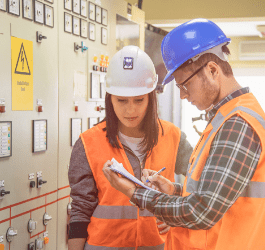Having Trouble? Press PLAY Podcast Here
If you’re not using some type of containment system in your data center, you’re likely sacrificing about a 30 percent improvement in cooling system performance.
So says Joe Capes, Business Development Director for Schneider Electric’s Cooling Line of Business in the Americas, in a podcast for the Schneider Electric Data Center Blog.
Containment systems prevent hot and cold air streams from mixing with one another in a data center. “What you really want to do is mitigate the potential for that hot and cold air to mix because it can really negatively effect your cooling efficiency and cooling capacity,” Capes says.
There are two approaches to containment, one that focuses on containing cold air and the other on hot air.
Cold air containment systems enclose the cold aisles in a data center, turning the rest of the data center into a large hot air return plenum. A hot aisle containment system encloses the hot aisle, collecting the hot exhaust air from IT equipment. The hot air may be sent to a computer room air handler (CRAH) or large remote air conditioning unit using a large chimney located over the entire hot aisle.
When putting a containment system in an existing data center, cold aisle containment is typically the way to go because it takes advantage of existing perimeter cooling units, is easier to deploy and has fewer physical constraints, Capes says.
“I like to see hot aisle containment used in new-build applications,” Capes says. “It’s really effective if you’re using in-row, close-coupled cooling and also where you’re using a mixture of traditional cooling along with high- or mid-density zones.”
Indeed, Schneider Electric conducted an analysis that shows hot aisle containment can provide about 40% more savings than cold-aisle systems.
The exact savings any given customer will get from containment systems depends on a number of factors. “It’s fair to say that the typical benefit is in the range of about 30 percent gained in performance,” Capes says. “I was just running an application for a client in Las Vegas and the difference between using hot aisle containment and not using it was a 28% improvement in the COP, the coefficient of performance, at 100% load. That was one specific example where the return was about 30% improved efficiency in performance.”
Containment systems also mesh well with cooling economizer technology, which involves using outside air to help cool a data center. “One of the huge benefits is that, especially with hot aisle containment, you can really increase the return air temperature to your cooling system,” Capes says. “That has the benefit of a higher delta T for both your in-room or in-row cooling units as well as your outside plant, your chiller plant as an example. The higher the delta T and the higher the return air or return water temperatures, the better the performance and efficiency of your entire cooling loop.”
For more information on Economizers, please see our first podcast in this series.
To learn more about containment systems, listen to our entire podcast with Joe Capes.




Conversation
Thank you.
An interesting article describing the energy-efficient and environmentally friendly solutions.